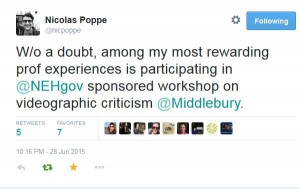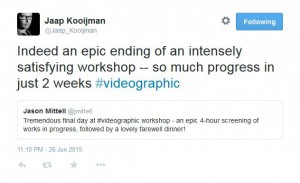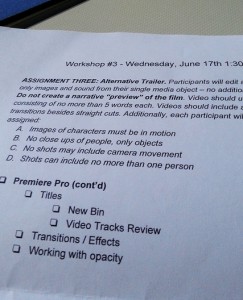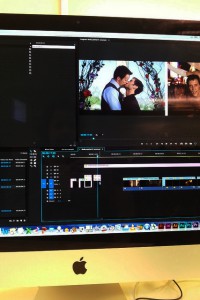Videographic Criticism 101
Post by Melanie Kohnen, New York University
 I spent the last two weeks of June at Scholarship in Sound & Image: A Workshop in Videographic Criticism at Middlebury College. A generous grant from the Office of Digital Humanities at the NEH made it possible for fourteen scholars to live and work together for two weeks, resulting in an experience that is among the most rewarding of my entire career.
I spent the last two weeks of June at Scholarship in Sound & Image: A Workshop in Videographic Criticism at Middlebury College. A generous grant from the Office of Digital Humanities at the NEH made it possible for fourteen scholars to live and work together for two weeks, resulting in an experience that is among the most rewarding of my entire career.
 Our hosts Chris Keathley and Jason Mittell, both faculty members in Film & Media Culture at Middlebury, designed a workshop that conveyed technical skills and stimulated discussions about how to craft scholarship in the form of the video essay. The combination of carefully planned exercises and informal conversations at our shared dorm, at the dining hall, or at the computer lab made this a truly unique and intensely lived experience.
Our hosts Chris Keathley and Jason Mittell, both faculty members in Film & Media Culture at Middlebury, designed a workshop that conveyed technical skills and stimulated discussions about how to craft scholarship in the form of the video essay. The combination of carefully planned exercises and informal conversations at our shared dorm, at the dining hall, or at the computer lab made this a truly unique and intensely lived experience.
 We spent the first week learning how to use Adobe Premiere (or, in some case, refining existing skills) through a series of five exercises. Starting on Day 2, we spent the mornings in small groups discussing our finished exercises and then usually screened everyone’s videos, followed by receiving our next assignment. Afternoons consisted of learning new aspects of Premiere and starting our video of the day. The assignments included a videographic Pecha Kucha, a trailer, a video with voiceover, a response to someone else’s video using multi-screen technique, and a video using epigraphs (see Jason Mittell’s post Making Videographic Criticism for more details on these daily exercises). Considering that as academics, our attention is often divided between many different tasks, it was wonderful to focus on finishing only one project at a time.
We spent the first week learning how to use Adobe Premiere (or, in some case, refining existing skills) through a series of five exercises. Starting on Day 2, we spent the mornings in small groups discussing our finished exercises and then usually screened everyone’s videos, followed by receiving our next assignment. Afternoons consisted of learning new aspects of Premiere and starting our video of the day. The assignments included a videographic Pecha Kucha, a trailer, a video with voiceover, a response to someone else’s video using multi-screen technique, and a video using epigraphs (see Jason Mittell’s post Making Videographic Criticism for more details on these daily exercises). Considering that as academics, our attention is often divided between many different tasks, it was wonderful to focus on finishing only one project at a time.
Each participant selected one familiar text to work on during the entire first week, ranging from The Water Nymph, Trouble in Paradise, The Magnificent Ambersons, Imitation of Life, Belle de Jour, The Stepford Wives, Suspiria, to La Ciénaga. I worked on the web series Husbands. I had closely analyzed the series before in traditional academic writing, but cutting up and rearranging it revealed new aspects about content and characters. For example, I re-evaluated my previous rather harsh critique of the queer representation in the series, and I realized that one of the protagonists is on screen more frequently than the other. At the end of the week, I also knew far more about video and sound editing than I had anticipated (shout-out and thank you to Ethan Murphy, Film & Media Culture’s Digital Media Specialist, and Stella Holt, a recent graduate of Film & Media Culture, who were always around to provide technical advice).
 During the second week, we worked on drafting a video essay, and we had videographic experts Eric Faden, Catherine Grant, and Kevin B. Lee join our workshop. It was immensely useful to hear Eric, Katie, and Kevin talk about their approaches to creating video essays and to be able to get their feedback on our drafts. I talked to both Katie and Kevin at length about how to structure my video essay on Husbands since I didn’t want to include a guiding voiceover but rather wanted to let the argument emerge mostly through editing and select on-screen text. My intention to skip the voiceover—a staple in many video essays—certainly stems from my familiarity with fan-made remix videos that excel at cultural critique through the use of editing and music alone.
During the second week, we worked on drafting a video essay, and we had videographic experts Eric Faden, Catherine Grant, and Kevin B. Lee join our workshop. It was immensely useful to hear Eric, Katie, and Kevin talk about their approaches to creating video essays and to be able to get their feedback on our drafts. I talked to both Katie and Kevin at length about how to structure my video essay on Husbands since I didn’t want to include a guiding voiceover but rather wanted to let the argument emerge mostly through editing and select on-screen text. My intention to skip the voiceover—a staple in many video essays—certainly stems from my familiarity with fan-made remix videos that excel at cultural critique through the use of editing and music alone.
Spontaneous screenings of works-in-progress in small groups provided further suggestions. This intensely collaborative atmosphere set the workshop apart from the often solitary work of Humanities scholars and makes me wish that we could create scholarship in collaborative ways more often.
The second week ended with a four-hour screening and discussion of our video essay drafts. The range and creativity in the presented works was impressive, especially considering that most of us had never used Premiere before arriving at Middlebury. A selection of these video essays will be revised for a special issue of [in]transition, a peer-reviewed journal of videographic criticism. We have also begun talking about a workshop for the upcoming SCMS ’16 conference. I certainly hope that another iteration of this workshop will happen again, either at Middlebury or at another institution. What we learned during the two weeks at “video camp” is too valuable not to share more widely. There is also much left to explore regarding the format of the video essay and which kinds of scholarship it suits best. For form and content analyses, the video essay is a rich tool, but I still wonder how the video essay can work for Media Industries Studies, for example, which is a field of inquiry dedicated to exploring the production, circulation, and reception of media texts. How can you represent a para-textual analysis in the format of the video essay?
To my fellow videographers, I’m already looking forward to our reunion at SCMS next year, and remember: we’re all winners, baby.
My multi-screen exercise “Brady and Cheeks Watch TV,” which samples videos made by other workshop participants. Inspired by the remix video Channel Hopping from _mesk on Vimeo.
Select work produced by #videographic participants at the workshop:
Corey Creekmur’s AmbersonsBachelard
Allison de Fren’s Stepford Wives Trailer
Shane Denson’s Sight and Sound Conspire: Monstrous Audio-Vision in James Whale’s Frankenstein (1931)
Liz Green’s Velvet Elephant
Patrick Keating’s Epigraph Exercise: Trouble in Paradise
Jaap Kooijman’s Close|Up
Jason Mittell’s The Logic of Mulholland Drive



What a cool workshop! I especially appreciated getting to learn about the exercises that helped y’all learn these skills. And I personally also come more from the fan-made video remix tradition so I applaud your interest in keeping the no-voiceover constraint.
For form and content analyses, the video essay is a rich tool, but I still wonder how the video essay can work for Media Industries Studies, for example, which is a field of inquiry dedicated to exploring the production, circulation, and reception of media texts. How can you represent a para-textual analysis in the format of the video essay?
I did a bit of this sort of thing in my fanvid “Pipeline”, in case that’s of interest!
Thank you so much for sharing your vid–it is fantastic and exactly what I was talking about! It uses the language of vidding so well to make its point, including the song. I got the feeling during our workshop that using a pop song comes too close to the music video for some scholars, implying that a music video is not/cannot be scholarship. I don’t agree with that. I think that the voice-over is (or seems to be) a more acceptable framing tool than a pop song in a video essay because it stems from the “serious” genre of the documentary. So there is definitely still room for discussion of why we might consider some formal strategies more “scholarly” than others…
Looks like you have had a awesome experience during this, soon will be part of workshop like this.
Regards
Thank you! What’s the workshop that you are participating in? I’d love to hear more about it.
Thanks so much for the summary of what sounds like an amazing workshop. I hope its success will encourage others like it; my students often describe themselves as “visual learners” (sometimes code for “I haven’t done the reading”) and these kinds of video essays offer a potentially very rewarding way of condensing arguments without sacrificing complexity that would otherwise require a great deal of reading (Corey Creekmur’s piece, for example, works well in this regard). I am equally impressed with the pieces that are less straightforward, as they offer students new ways to think about how different kinds of texts talk to each other.
I agree with the author here that fan-made remix video does similar kinds of critical work and I have also utilized remix to great effect in my classes. I hope that more scholarly and institutional investment in the video essay will in turn draw more scholarly attention to the work of remix creators and help to make the cultural and professional hierarchies that often separate these two forms of formal creativity and cultural critique less acute. They have much to say to one another.
Finally, I really appreciate the participants’ willingness to post their exercises online, and it would be wonderful to have an official (SCMS-sponsored?) repository of such video essays available for media scholars to use in our classes. And, of course, more workshops for all!
I agree that the video essay has great potential for teaching as well. We didn’t really talk about the video essay as a teaching tool so much, but we did think about how to teach the video essay or how to include some of the technical exercises to get students to think about film differently.
Yes, definitely. I certainly think that the genre of the video essay can learn a lot from fan videos about framing arguments through editing decisions alone, without having to rely on on-screen text or voice-over. The use of pop music in many vids seems to be a point of hesitation for some scholars, so that’s something to talk about in more depth.
There’s a conversation going on about proposing a workshop on our experience for next year’s SCMS conference, and if that happens, putting together a repository seems like a great idea. In the meantime, looking through participants’ Vimeo channels is probably the best alternative.